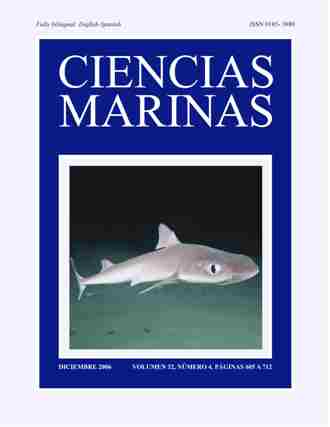Modeling winter circulation and particle retention in the Magdalena-Almejas Bay lagoon system (Baja California Sur, Mexico)
Main Article Content
Abstract
Se describe la circulación y el transporte pasivo de partículas en las inmediaciones del sistema lagunar Bahía Magdalena- Almejas mediante un modelo lineal de circulación en el dominio de la frecuencia con el que se obtuvieron los campos básicos de flujo. El modelo está forzado por mareas, marea residual, viento medio, viento periódico para simular el efecto de la brisa marina y una simulación aproximada del efecto de la Corriente de California. Se realizaron dos experimentos principales, uno enfocado a detectar zonas de retención en el interior del sistema lagunar, y el segundo para observar el intercambio de partículas entre el sistema y el océano abierto adyacente. Se encontró que las partículas sembradas en el sistema tienden a quedarse dentro y concentrarse en regiones particulares que se correspondieron con la distribución real de bancos pesqueros de recursos bentónicos y, en segundo término, que durante condiciones poco comunes de viento se pueden presentar intrusiones importantes de partículas de la plataforma continental al interior del sistema lagunar. Los resultados son de importancia para el estudio de la zona en general, y particularmente para la modelación y desarrollo de pronósticos de procesos de deriva larval de recursos pesqueros importantes.
We describe circulation and passive particle transport in the Magdalena-Almejas Bay lagoon system through a linear circulation model in the frequency domain to obtain basic flux fields. The model is forced by tides, residual tides, mean wind speed, periodic winds (to simulate sea breeze), and an approximation of advection in the California Current. Two main experiments were performed: one to detect retention zones within the lagoon system and another to evaluate particle exchange between the lagoon system and the open ocean. We found that particles seeded within the system tend to remain inside and concentrate in restricted areas that correspond to the real distribution of benthic fish and that, under rare wind conditions, masses of particles seeded on the continental shelf could enter the lagoon system. The results are relevant for the general study of the system and for modeling and developing forecasts of the larval drift of important fish resources.
We describe circulation and passive particle transport in the Magdalena-Almejas Bay lagoon system through a linear circulation model in the frequency domain to obtain basic flux fields. The model is forced by tides, residual tides, mean wind speed, periodic winds (to simulate sea breeze), and an approximation of advection in the California Current. Two main experiments were performed: one to detect retention zones within the lagoon system and another to evaluate particle exchange between the lagoon system and the open ocean. We found that particles seeded within the system tend to remain inside and concentrate in restricted areas that correspond to the real distribution of benthic fish and that, under rare wind conditions, masses of particles seeded on the continental shelf could enter the lagoon system. The results are relevant for the general study of the system and for modeling and developing forecasts of the larval drift of important fish resources.
Downloads
Download data is not yet available.
Article Details
How to Cite
Morales-Zárate, M., Aretxabaleta, A., Wermer, F., & Lluch-Cota, S. (2006). Modeling winter circulation and particle retention in the Magdalena-Almejas Bay lagoon system (Baja California Sur, Mexico). Ciencias Marinas, 32(4), 631–647. https://doi.org/10.7773/cm.v32i4.1162
Issue
Section
Research Article
This is an open access article distributed under a Creative Commons Attribution 4.0 License, which allows you to share and adapt the work, as long as you give appropriate credit to the original author(s) and the source, provide a link to the Creative Commons license, and indicate if changes were made. Figures, tables and other elements in the article are included in the article’s CC BY 4.0 license, unless otherwise indicated. The journal title is protected by copyrights and not subject to this license. Full license deed can be viewed here.

